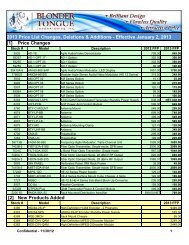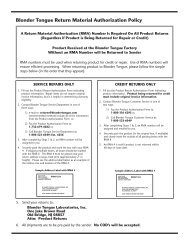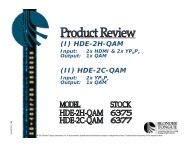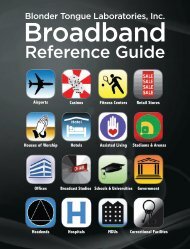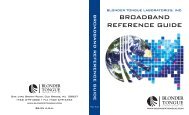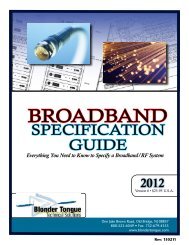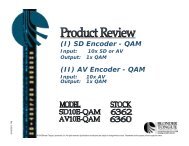Functional Block Diagram - Blonder Tongue Laboratories Inc.
Functional Block Diagram - Blonder Tongue Laboratories Inc.
Functional Block Diagram - Blonder Tongue Laboratories Inc.
You also want an ePaper? Increase the reach of your titles
YUMPU automatically turns print PDFs into web optimized ePapers that Google loves.
Broadband Specification Guide<br />
Equipment Specifications Library<br />
MPG-1100<br />
A high-speed broadband Internet access solution over coaxial cable shall be equal to <strong>Blonder</strong> <strong>Tongue</strong>’s MPG-1100 and shall meet or exceed the following specifications:<br />
a) 10/100 BaseT Ethernet Port<br />
g) Symbol Rate: 1 to 4 Msym/sec<br />
WAN/LAN Interface<br />
h) Bandwidth: 1.15 to 6.9 MHz<br />
b) Remote or Local provisioning and control<br />
i) Spurious: -60 dBc<br />
c) Frequency Range D/S: 40 to 80 MHz<br />
j) Receive Range: -10 to +15 dBmV<br />
d) Frequency Range U/S: 5 to 32 MHz<br />
e) Output Level: +50 dBmV<br />
f) Modulation Type: QAM 64<br />
MPO-ESM-XX<br />
A high-speed broadband Internet access solution over coaxial cable shall be equal to <strong>Blonder</strong> <strong>Tongue</strong>’s MPO-ESM-XX Series and shall meet or exceed the<br />
following specifications:<br />
a) MAC Address Identifier<br />
b) In/Out Coaxial Female F Connector<br />
c) 10BaseT RJ-45 Receptacle<br />
d) Transmission Level: +48 dBmV Max.<br />
e) Modulation Type: QPSK<br />
f) Symbol Rate: 1.5 to 3 Msym/sec<br />
g) Bandwidth: 1.875 to 3.75 MHz<br />
MSBC<br />
The sub band block converter shall be housed in a modular die cast chassis. It shall accept sub band input channels T7-T13 and convert them to VHF highband<br />
channels 7 to 13. The sub band converter shall be equal to <strong>Blonder</strong> <strong>Tongue</strong> MSBC and shall meet or exceed the following specifications:<br />
a) Input Frequency Range: 5.75-47.75 MHz<br />
b) Output Frequency Range: 174-216 MHz<br />
c) Output Level: 45 dBmV Minimum<br />
d) Recommended Input Level: 0 to +20 dBmV<br />
e) Conversion Gain: 3 dB<br />
OC-8D<br />
The channel combiner shall have eight (8) input ports for combining signal sources in the headend. The combiner shall be internally constructed of -120 dB radiation<br />
proof passives. The combiner shall have a -20 dB test point for testing of signals without interruption or service. The combiner shall be equal to <strong>Blonder</strong> <strong>Tongue</strong> OC-8d,<br />
and shall meet or exceed the following specifications:<br />
a) Frequency Range: 5-1000 MHz<br />
b) Impedance: 75 Ω<br />
c) Output Test Port: -20 dB<br />
d) Return Loss:<br />
(1) Input: 17 dB Minimum<br />
(2) Output: 17 dB Minimum<br />
e) Isolation<br />
(1) Adjacent Ports: 25 dB Minimum<br />
(2) Non-Adjacent Ports: 50 dB Minimum<br />
OC-12D<br />
h) Receive Range: -10 to +40 dBmV<br />
i) Frequency Range D/S:<br />
a. MPO-ESM-52 — 48 to 56 MHz<br />
b. MPO-ESM-70 — 64 to 76 MHz<br />
j) Frequency Range U/S: 5 to 32 MHz<br />
f) Flatness: 1.5 dB PV<br />
g) Input Return Loss: 15 dB<br />
h) Output Return Loss: 17 dB<br />
The channel combiner shall have twelve (12) input ports for combining signal sources in the headend. The combiner shall be internally constructed of -120 dB<br />
radiation proof passives. The combiner shall have a -20 dB test point for testing of signals without interruption or service. The combiner shall be equal to <strong>Blonder</strong><br />
<strong>Tongue</strong> OC-12d, and shall meet or exceed the following specifications:<br />
a) Frequency Range: 5-1000 MHz<br />
b) Impedance: 75 Ω<br />
c) Output Test Port: -20 ±2 dB<br />
d) Return Loss:<br />
(1) Input: 13 dB Minimum<br />
(2) Output: 13 dB Minimum<br />
f) Insertion Loss: 24 dB Maximum<br />
g) Slope: 1.50 dB<br />
h) Flatness: ±0.20 dB Relative to Slope<br />
e) Isolation<br />
(1) Adjacent Ports: 25 dB Minimum<br />
(2) Non-Adjacent Ports: >40 dB<br />
f) Insertion Loss: 20 dB Maximum<br />
74



